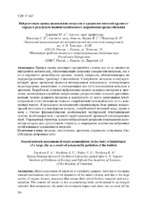| dc.contributor.author | Тунакова, Ю. А. | ru |
| dc.contributor.author | Новикова, С. В. | ru |
| dc.contributor.author | Валиев, В. С. | ru |
| dc.contributor.author | Новикова, К. Н. | ru |
| dc.coverage.spatial | Минск | ru |
| dc.date.accessioned | 2024-04-10T05:48:18Z | |
| dc.date.available | 2024-04-10T05:48:18Z | |
| dc.date.issued | 2024 | |
| dc.identifier.citation | Нейросетевая оценка накопления металлов в организме жителей крупного города в результате полиметаллического загрязнения среды обитания = Neural network assessment of metal accumulation in the body of inhabitants of a large city as a result of polymetallic pollution of the habitat / Ю. А. Тунакова [и др.] // XII Форум вузов инженерно-технологического профиля Союзного государства : сборник научных трудов / Белорусский национальный технический университет ; ред. Т. В. Матюшинец. – Минск : БНТУ, 2024. – С. 210-218. | ru |
| dc.identifier.uri | https://rep.bntu.by/handle/data/141789 | |
| dc.description.abstract | Прямая оценка ретенции чрезвычайно сложна как из-за множества внутренних механизмов, обеспечивающих динамику содержания металлов, так и из-за огромного разнообразия органов, тканей, процессов, обеспечивающих их перераспределение, транспорт и накопление. Содержание металлов в аккумулирующей среде организма является интегральным показателем, суммирующим мультисредовое воздействие и учитывающим все пути поступления металлов в организм. Разработана сложная нейросетевая модель задержки металлов в организме, включающая ансамбли нейросетевых регрессионных моделей, рассчитывающих уровни задержки металлов в зависимости от места проживания детей-подростков и поступления не только с потребляемой питьевой водой, но и с вдыхаемый воздух. В результате исследований сформирована база данных концентраций металлов в атмосферном воздухе, потребляемой питьевой воде, крови и моче с учетом физиологических особенностей тестируемой чувствительной группы детей-подростков с целевой территориальной привязкой анализируемых проб. Упрощенная структура модели нейросетевой регрессии (уменьшение количества входов) дает достаточную точность, а сокращение количества нейронных сетей повышает адекватность моделей. | ru |
| dc.publisher | БНТУ | ru |
| dc.title | Нейросетевая оценка накопления металлов в организме жителей крупного города в результате полиметаллического загрязнения среды обитания | ru |
| dc.title.alternative | Neural network assessment of metal accumulation in the body of inhabitants of a large city as a result of polymetallic pollution of the habitat | ru |
| dc.type | Working Paper | ru |
| local.description.annotation | Direct assessment of retention is extremely complex, both due to the many internal mechanisms that ensure the dynamics of the metal content, and due to the huge variety of organs, tissues, processes that ensure their redistribution, transport and accumulation. The content of metals in the accumulating body environment is an integral indicator that summarizes the multi-environment impact and takes into account all the ways in which metals enter the body. A complex neural network model of metal retention in the body was developed, including ensembles of neural network regression models that calculate the levels of metal retention, depending on the place of residence of adolescent children and intake not only with consumed drinking water, but also with inhaled air. As a result of the studies, a database of metal concentrations in the atmospheric air, consumed drinking water, blood and urine was formed, taking into account the physiological characteristics of the tested sensitive group of adolescent children, with targeted territorial reference of the analyzed samples. The simplified structure of the neural network regression model (reducing the number of inputs) gives sufficient accuracy, and the reduction of neural networks increases the adequacy of the models. | ru |

